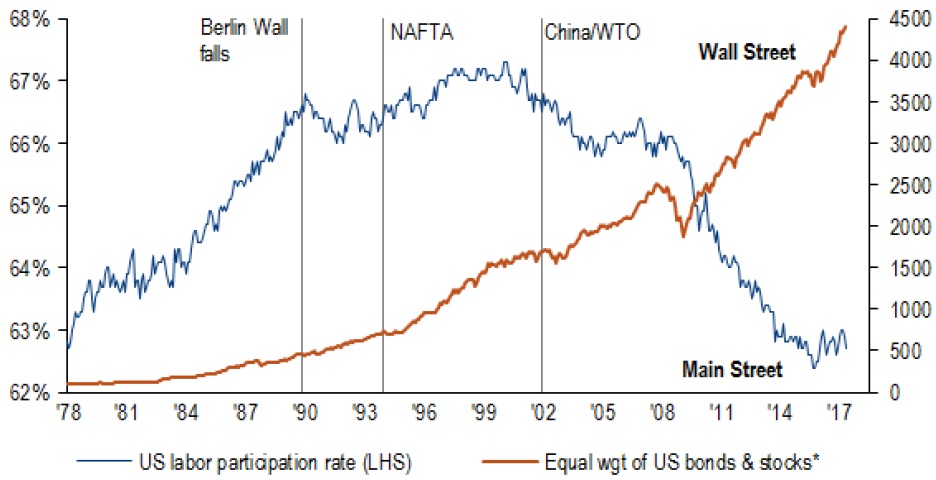Central bank easing may no longer be politically acceptable.
That’s what Bank of America Merrill Lynch’s widely followed chief investment strategist, Michael Hartnett, says in a note.
“Central banks have exacerbated inequality via Wall St. inflation & Main St. deflation; [it’s] no longer politically acceptable to stoke [the] Wall St. bubble,” the strategist wrote last week.
There are “two ways to cure inequality,” make the poor richer or the rich poorer, Hartnett added. The Federal Reserve and the European Central Bank are “now tightening to make Wall St. poorer,” likely setting up for a “big top” in stock markets this fall.
US labor participation rate vs. US stocks and bonds

Source: Bank of America Merrill Lynch Global Investment Strategy
Last week, European and U.S. government bond yields climbed to multiweek highs after key policymakers at the European Central Bank, Bank of England and Federal Reserve separately suggested that tighter monetary policy is on the way.
However, all three acknowledged inflation remains subdued.
Normal business growth can no longer create inflation because of the disruptive force of technology, record high global debt, and an aging population, Hartnett said. Instead, he said, inflation will require “radical fiscal stimulus, trade war, major increase in geopolitical risk” and policies to “Occupy Silicon Valley” by redistributing its wealth, reiterating a point he made in May.
In Hartnett’s view, the lack of inflation means central banks are making a “mistake” by tightening, but they will still do so because they “want volatility to return.”
This summer will then likely mark a “significant inflection point” in the central bank liquidity trade that will likely set up for a “big top” in the autumn, Hartnett said. He recommends buying 2-year Treasurys and resources stocks, and shorting emerging market debt and technology stocks, among several other trades in preparation for a “bout of higher yields.”
While yields climbed last week and bank stocks rose, the tech-heavy Nasdaq composite fell 1.99 percent in its worst week of the year, going back to Dec. 2. The S&P 500 fell 0.61 percent last week, its worst since April 13.
Still, “‘greed’ takes longer to kill than ‘fear,'” the market strategist said. He pointed out that in the 12 months leading up to the tech bubble’s peak, the Nasdaq fell more than 10 percent on six separate occasions.
Hartnett expects the Nasdaq composite could climb above 6,666 before the end of the bull market — which he pointed out began after the S&P 500 hit a low of 666 — 666.79 per FactSet, to be precise.
Source: Investment Cnbc
Market top coming because Fed's easy money 'no longer politically acceptable,' Bank of America says